Carers are a vital part of our society, allowing neighbours and loved ones to continue thriving in the community. In Essex there are estimated to be as many as 154,000 adults providing unpaid care. Improving access to advice, guidance and support for carers is one of ECC’s 20 commitments for levelling up the county. To achieve that it’s vitally important we understand how carers feel, and how caring duties may impact their lives, such as their ability to maintain paid employment.
In addition to using traditional research techniques ECC uses to understand carers’ lives, such as Carers Survey data and focus groups, we wanted to maximise the value of the text data we hold from social care assessments.
Exploring text data relating to carers provides us with a new opportunity to understand how carers describe their experiences and what types of tasks they request support with, and importantly, whether these requests relate to employment.
To do this we used a relatively new technique to ECC called Natural Language Processing (NLP). We analysed a mix of carers assessments and joint assessments, 2414 cases over two years. We specifically looked at the case summaries, which provided an overview of the situation usually written by a social worker, and the carers views, which provide a first-hand account. We also looked at assessment questions that related directly to employment. Further to the text answers we used structured data fields from within the assessment forms that we haven’t previously explored, to give a more granular understanding – including type, frequency and level of support, employment situation. We then used NLP to analyse text and look for themes, identify frequent or significant words and phrases, and analyse by sentiment to capture positive and negative attitudes and experiences.
What our analysis found
1. What support do carers provide?
This question was answered by assessing the structured data fields where carers had checked whether they provide certain tasks. While this made analysis of the data straightforward there was a low response rate, as only ~25% of our sample of carers answered the question. Of those that did answer, 95% provided daily care with the various types of support highlighted in Figure 1.
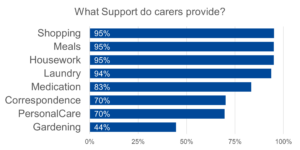
Figure 1: Tasks performed by carers who gave any response to section regarding caring activities.
2. What are the significant words or phrases occurring in the carer’s views text summaries?
To extract key words and phrases from the text we created word clouds of pairs of words (bigrams), triplets of words (trigrams), and quadruplets of words (quadgrams or 4-grams). These word clouds highlighted a need for increased breaks and more time (Figure 2).
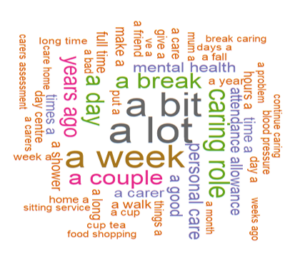
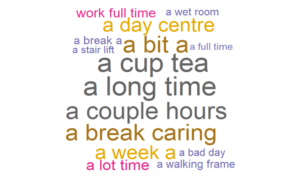
Figure 2: word clouds of most common phrases in the carer’s views section within the carers summary largely mention a need for more time and breaks.
3. How does employment status change sentiment, and what are the most important phrases associated with employed and unemployed carers who have positive and negative views?
This final question involved performing sentiment analysis on the carers views text and assigning a score on their overall sentiment, i.e. were the views of the carer largely positive or negative? We then split our sample of carers into two groups: employed (these included those in unpaid work or education) and unemployed.
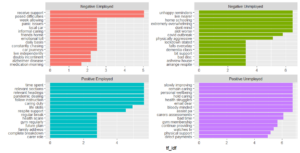
Overall, 56.62% unemployed people have an overall positive sentiment and 65.48% of employed people have a positive sentiment, with multiple cases stating positive benefits of continuing to work where possible.
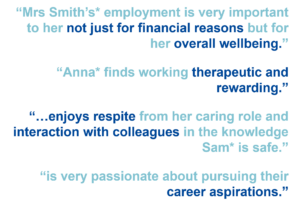
Our findings evidence what we previously only knew anecdotally about the challenges faced by carers balancing caring roles with work. These results are just the tip of the iceberg in terms of what is possible with NLP and show how we can use previously unused fields to access the views of carers in their own words without the need for a lengthy audit. In addition, it has highlighted opportunities to identify:
- Groups not currently receiving assessments. In this work 95% of carers care daily however, in the state of caring survey last year 1 in 4 were reported to care less than 25 hours per week. We now need to look at how we can target these more effectively
- Carers providing specific support types.
Finally, this project has given us the potential to track and measure changes and impact as recording improves and see how sentiment in carers views change over time.
Leave a comment